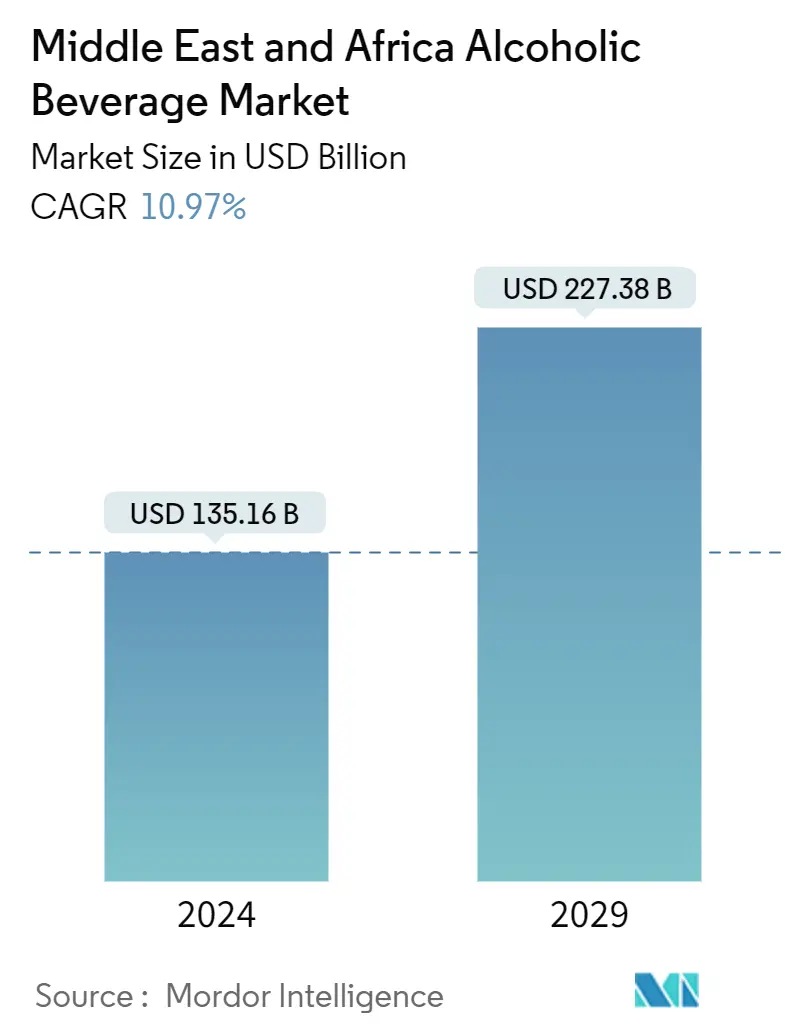Market Size of Middle East & Africa Alcoholic Beverage Industry

| Study Period | 2019-2029 |
| Market Size (2024) | USD 135.16 Billion |
| Market Size (2029) | USD 227.38 Billion |
| CAGR (2024 - 2029) | 10.97 % |
| Fastest Growing Market | Africa |
| Largest Market | Africa |
Major Players.webp)
*Disclaimer: Major Players sorted in no particular order |
MEA Alcoholic Beverages Market Analysis
The Middle East & Africa Alcoholic Beverage Market size is estimated at USD 135.16 billion in 2024, and is expected to reach USD 227.38 billion by 2029, growing at a CAGR of 10.97% during the forecast period (2024-2029).
- The sales of alcoholic beverages are increasing due to the rising socializing trend worldwide. Additionally, it is projected that the popularity of pubs, taverns, and restaurants during the forecast period will further boost market expansion. The growth of the Middle East and African alcoholic beverage market is likely to be driven by the increased consumption of alcohol across the young adult demographics in the near future.
- Additionally, the increasing demand for premium alcoholic beverages and curiosity among consumers, specifically among millennials, is pushing them to try alcoholic products. This is expected to positively impact the growth of the alcoholic beverage industry in the region. However, strict restrictions, increased taxes, and tariffs imposed by the Middle East and African governments are expected to slow the growth in the region.
- The growing preference for non-alcoholic beverages is also impeding industry expansion. To boost sales, major players are currently concentrating on releasing cordials and alcoholic drinks with lower alcohol content. They are also analyzing Internet retailing from the e-commerce platform to capitalize on the rising demand for value-added complex seltzer products at competitive prices. Such innovations are projected to increase product commercial possibility, which can subsequently spur market expansion.
MEA Alcoholic Beverages Industry Segmentation
An alcoholic beverage is a drink that contains ethanol, a type of alcohol produced by the fermentation of grains, fruits, or other sources of sugar.
The Middle East and African alcoholic beverage market is segmented by product type into beer, wine, and spirits. Based on the distribution channel, the market has been segmented into on-trade and off-trade channels. The off-trade segment is further sub-segmented into supermarkets/hypermarkets, specialty stores, online retail stores, and other off-trade channels. The market is also segmented by geography into South Africa, the United Arab Emirates, Bahrain, Oman, Qatar, and the Rest of the Middle East and Africa.The market sizing has been done in value terms in USD for all the abovementioned segments.
| Product Type | |
| Beer | |
| Wine | |
| Spirits |
| Distribution Channel | ||||||
| On-trade | ||||||
|
| Geography | |
| South Africa | |
| United Arab Emirates | |
| Bahrain | |
| Oman | |
| Qatar | |
| Rest of Middle East and Africa |
Middle East & Africa Alcoholic Beverage Market Size Summary
The Middle East and Africa alcoholic beverage market is experiencing significant growth, driven by increasing socialization trends and the rising popularity of pubs, taverns, and restaurants. This expansion is further fueled by the growing consumption of alcohol among young adults and the demand for premium alcoholic beverages, particularly among millennials. However, the market faces challenges from strict government regulations, increased taxes, and a growing preference for non-alcoholic beverages. To counter these challenges, major industry players are focusing on innovation, such as introducing cordials and low-alcohol drinks, and leveraging e-commerce to meet the demand for value-added products. These strategies are expected to enhance the commercial viability of alcoholic beverages in the region.
The demand for low-alcohol-by-volume beverages is on the rise, particularly among health-conscious consumers and those prioritizing responsible drinking. This trend is supported by a broader product portfolio offering improved taste, appealing to consumers' preferences for lower calorie and sugar content. Manufacturers are capitalizing on this interest by introducing products like low-alcohol wines and craft beers. South Africa leads in alcohol consumption, influenced by Western social habits and the availability of diverse brands. The market is moderately fragmented, with major players like Diageo, Heineken, and Pernod Ricard expanding their presence through geographical expansion and product innovation. The growth of e-commerce and social media further supports the market's expansion, providing effective retail channels and enhancing brand visibility.
Middle East & Africa Alcoholic Beverage Market Size - Table of Contents
-
1. MARKET DYNAMICS
-
1.1 Market Drivers
-
1.1.1 Growing Preference for Low Alcohol by Volume (ABV)
-
1.1.2 Tourism and Expat Communities Driving Consumption
-
-
1.2 Market Restraints
-
1.2.1 Government Regulatory Frameworks Limits Alcohol Consumption
-
-
1.3 Porter's Five Forces Analysis
-
1.3.1 Threat of New Entrants
-
1.3.2 Bargaining Power of Buyers/Consumers
-
1.3.3 Bargaining Power of Suppliers
-
1.3.4 Threat of Substitute Products
-
1.3.5 Intensity of Competitive Rivalry
-
-
-
2. MARKET SEGMENTATION
-
2.1 Product Type
-
2.1.1 Beer
-
2.1.2 Wine
-
2.1.3 Spirits
-
-
2.2 Distribution Channel
-
2.2.1 On-trade
-
2.2.2 Off-trade
-
2.2.2.1 Supemarkets/Hypermarkets
-
2.2.2.2 Specialty stores
-
2.2.2.3 Online Retail Stores
-
2.2.2.4 Other Off-Trade Channels
-
-
-
2.3 Geography
-
2.3.1 South Africa
-
2.3.2 United Arab Emirates
-
2.3.3 Bahrain
-
2.3.4 Oman
-
2.3.5 Qatar
-
2.3.6 Rest of Middle East and Africa
-
-
Middle East & Africa Alcoholic Beverage Market Size FAQs
How big is the Middle East & Africa Alcoholic Beverage Market?
The Middle East & Africa Alcoholic Beverage Market size is expected to reach USD 135.16 billion in 2024 and grow at a CAGR of 10.97% to reach USD 227.38 billion by 2029.
What is the current Middle East & Africa Alcoholic Beverage Market size?
In 2024, the Middle East & Africa Alcoholic Beverage Market size is expected to reach USD 135.16 billion.

